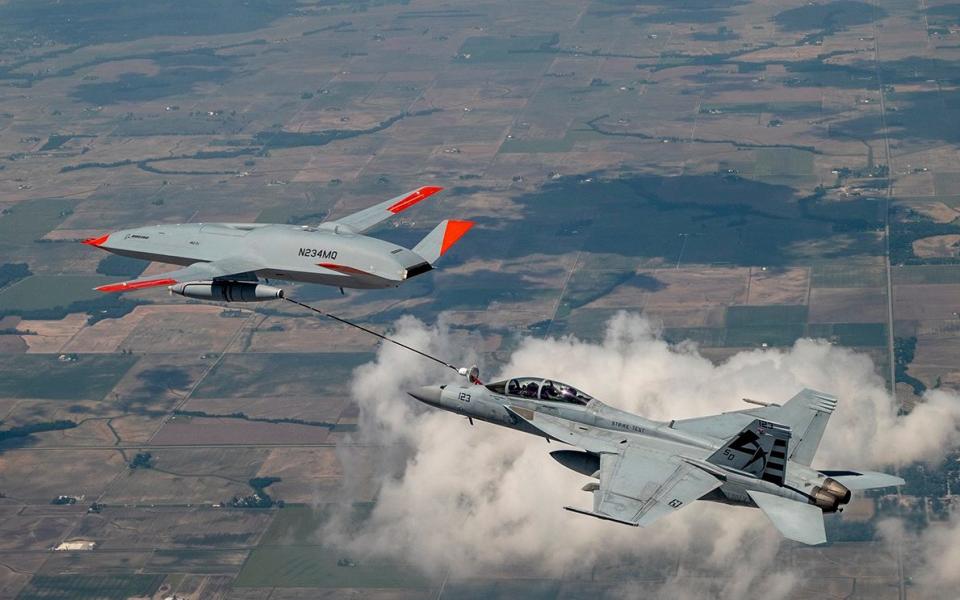The US Navy has an unmanned 5th generation carrier stealth jet. It could be a game changer
US aerospace firm Boeing is still hoping that the new MQ-25 Stingray drone it’s building for the US Navy’s aircraft carriers could be armed for combat. Sure, there’s a profit motive. But Boeing isn’t wrong. Adding missiles to the long-ranging, Stealthy MQ-25 – the Navy’s first in service carrier-capable drone – is a really good idea.
Put simply, the MQ-25 is the only aircraft currently in development for the Navy’s carrier air wings that possesses the range to strike at Chinese forces without forcing the carrier itself to sail dangerously close to those same forces.
The Navy tapped Boeing to build the tanker drone back in 2018. Six years later, the first batch of drones is in production at the company’s new factory in Missouri. The Navy expects the $180-million drones to deploy for the first time in 2026.

As the Navy envisions it, the 51-foot MQ-25 is strictly an air-to-air tanker – for now. Its sole mission is to refuel manned planes in order to extend their range. But with a little imagination, the MQ-25 itself could become a long-range strike asset. Significantly, it has fifth-generation Stealth technology.
Boeing showed how the MQ-25 could become a strike platform. At a trade show in Maryland earlier this month, the firm displayed a scale model of the satellite-controlled MQ-25 with a pair of Long-Range Anti-Ship Missiles, or LRASMs, hanging under its wings. It’s a potent pairing.
The Navy’s concept for the stealthy MQ-25 is that one drone, out of a detachment of between five and eight drones assigned to a carrier air wing, would take off ahead of the manned fighters, fly out to a distance of 500 miles from the carrier – and then wait.
When a flight of four fighters arrives, the drone would offload 16,000 pounds of fuel via underwing pods and hoses, extending the range of each fighter to more than 600 miles.
Drone refueling helps the carrier air wings to claw back some of the striking distance they possessed late in the Cold War, when carrier decks were packed with far-flying Grumman A-6 Intruder bombers and F-14 Tomcat fighters plus Lockheed S-3 Viking tankers.
The A-6 could haul a useful bomb load a thousand miles. The F-14, which in the final few years of its career gained a secondary ground-attack role, could carry laser-guided bombs 600 miles. The S-3 could add a hundred miles or more to both types’ combat radius.
The Navy retired the A-6 in 1996, the F-14 in 2006 and the S-3 in 2009. Today Boeing F/A-18s and Lockheed Martin F-35Cs are the air wing’s main strike planes. They both range around 500 miles on internal fuel with a meaningful weapons load.
The shrinking strike radius of a carrier air wing has become a crisis as Chinese anti-ship ballistic missiles have increased in range. Around 2010, the Chinese rocket force introduced a thousand-mile variant of its DF-21 anti-ship rocket.
The DF-26, with more than double the range, appeared in 2016. The People’s Liberation Army Rocket Force possesses no fewer than 1,300 rockets, around 200 of which are the latest DF-26. Satellite pictures have revealed mockups of US warships set up as missile targets deep in China’s Gobi desert.
To strike at targets close to the Chinese mainland, an American carrier would have to sail well within range of the DF-26s. It would be no simple task for China to locate and track the ship – the carrier’s radar aircraft and fighters would keep aerial reconnaissance away, and there are serious difficulties in finding ships using satellites. Nonetheless, if China did manage to locate a carrier its escorts would have their hands full knocking down incoming ballistic missiles as the carrier launched and recovered jets. It’s a high-risk scenario.
But what if the MQ-25 kept all its fuel for itself – and carried the same missiles a manned fighter carries? In theory, an MQ-25 could range 2,000 miles from the carrier and then shoot its LRASMs at targets another 200 or 300 miles away.
Yes, the carrier would still have to sail within range of the DF-26: but only just within. As a bonus, losing a manned fighter often means losing a pilot. Lose a drone, however, and it’s just a financial write-down.
To be clear, Navy officials long have mulled new missions for the 76 MQ-25s the fleet plans to buy. Maybe it could conduct reconnaissance and surveillance missions. Maybe it could team up with smaller and faster armed drones. Last year, Navy lieutenant Josh Hano wrote an essay urging the Navy to “evolve the MQ-25 to complement – not replace – manned aircraft.”
In displaying a model of an armed MQ-25, Boeing is just reminding people of these good ideas that already have their champions. And also reminding the Navy that it could act swiftly to arm the far-flying drones, as soon as the government is ready to pay for it – and as soon as the US Navy’s pilots, who have been resisting automation for a long time, are willing to accept such a move.


